The Prescription Pharmacy Bags Market is estimated to be valued at USD 3.2 billion in 2025 and is projected to reach USD 5.2 billion by 2035, registering a compound annual growth rate (CAGR) of 5.0% over the forecast period.
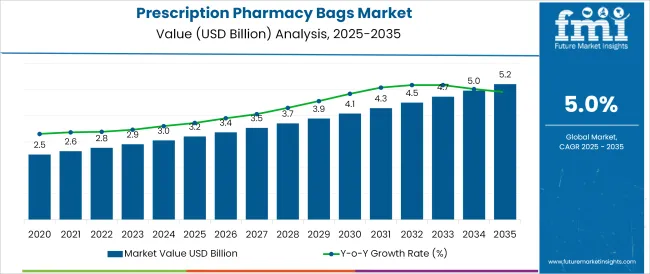
The prescription pharmacy bags market is witnessing sustained demand, propelled by the growing need for safe, hygienic, and regulation-compliant pharmaceutical packaging. The emphasis on protecting prescriptions from contamination, maintaining discretion, and aligning with environmental sustainability standards has driven innovation across both material and design. Increased footfall in retail and hospital pharmacies, particularly in urban centers, is creating consistent demand for high-throughput, disposable packaging.
Simultaneously, policy shifts toward eco-responsible healthcare packaging are encouraging manufacturers to adopt paper-based, recyclable formats. Operational needs such as barcode scanning, tamper evidence, and privacy labels are also influencing design trends.
As digital pharmacies and direct-to-patient deliveries continue to scale, packaging requirements are shifting toward formats that are both functionally robust and environmentally compliant. The market outlook remains optimistic, with regulatory alignment, patient experience, and sustainable material sourcing acting as key growth pillars.
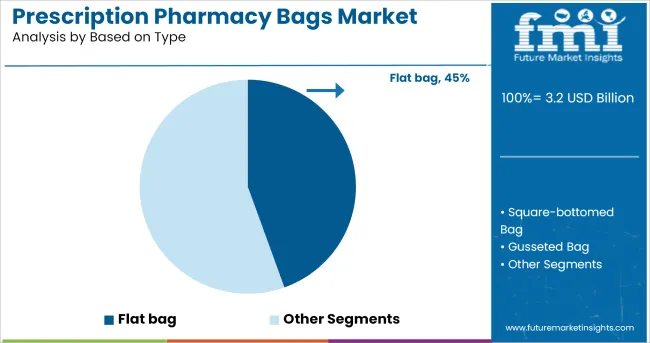
It is identified that flat bags account for 44.50% of total market share within the type segment, making them the most preferred format. This preference is attributed to their compact design, ease of storage, and cost-effective production.
Flat bags are favoured in high-volume pharmacy environments due to their compatibility with automation and fast dispensing systems. Their slim profile facilitates efficient storage and handling, while also reducing waste and material costs.
The format’s simplicity supports high customizability for branding and regulatory information without compromising speed or hygiene. Owing to these operational and economic benefits, flat bags have established a stronghold in the type category.
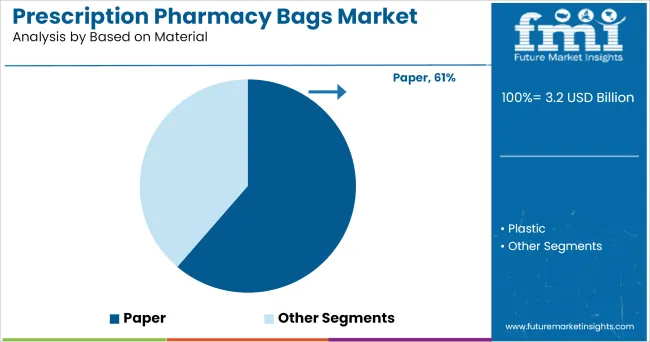
Within the material segment, paper is observed to command 61.30% of market share, positioning it as the dominant choice. This is driven by regulatory mandates and institutional sustainability targets that are shifting packaging standards away from plastics. Paper bags are increasingly adopted for their biodegradability, printability, and compatibility with secure closures.
Pharmacies have been opting for paper formats to reinforce environmentally conscious brand messaging while meeting privacy and compliance requirements. Additionally, the availability of coated and reinforced paper options has improved moisture resistance and structural integrity, further supporting this segment’s expansion.
These combined environmental and functional benefits have solidified paper’s leading position in the prescription pharmacy bags market.
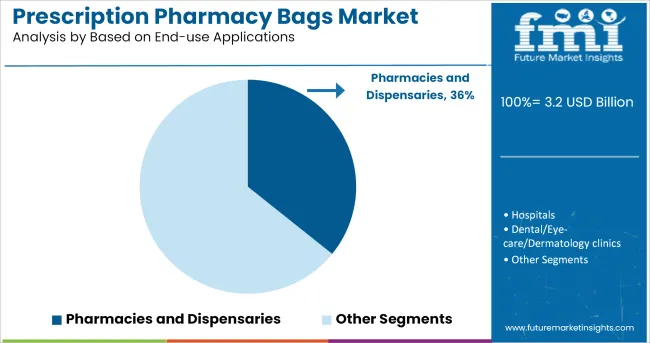
It has been observed that pharmacies and dispensaries contribute 35.80% to overall revenue within the end-use segment, making them the largest consumer group. This is due to the high frequency of prescription handling and the need for compliant, efficient packaging across walk-in and institutional settings.
As frontline healthcare providers, pharmacies require bags that support regulatory labeling, patient privacy, and quick dispensing operations. The rise in chronic disease management, increased outpatient visits, and expanded health services at pharmacies have further increased daily prescription volumes, reinforcing packaging demand.
Additionally, retail chains and independent pharmacies alike are aligning with green packaging initiatives, making reusable or recyclable options more common. As a result, pharmacies and dispensaries continue to be the primary end-users driving growth and innovation within the market.
Prescription pharmacy bags are widely used by pharmacies, hospitals, veterinary clinics, and dispensaries primarily to safeguard patients’ medical information. Most people prefer to keep their conditions private, as a variety of ailments may be considered distressing. The need to maintain confidentiality will drive the sales of prescription pharmacy bags.
Further, prescription pharmacy bags lend a sense of professionalism to pharmacies and healthcare facilities. While generic prescription pharmacy bags are the norm, businesses can personalise their bags with their logos as a way of reinforcing their brand and as a marketing tool. The aforementioned reasons are expected to drive the demand for customised prescription pharmacy bags.
Community pharmacies are vital because it provide patients with a direct point of contact, putting them on the front lines of public health. Following the Covid-19 outbreak, pharmacists faced a slew of issues, including operating with restricted resources and labour.
As countries re-open, community pharmacies will witness an increase in sales, which is anticipated to drive the demand for prescription pharmacy bags as it is convenient and sustainable.
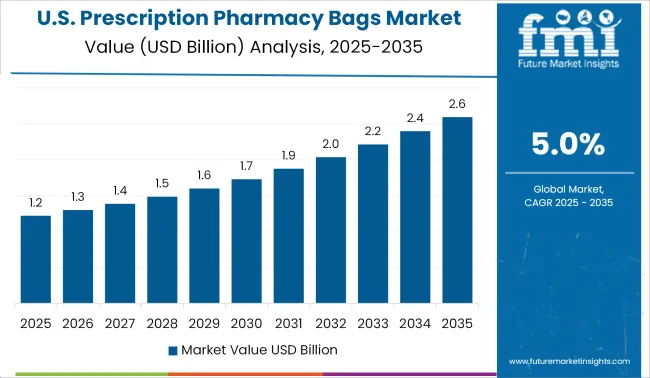
The USA and Canada market for prescription pharmacy bags is estimated to witness steady growth owing to manufacturers investing in innovations and sustainable technology in the region. Many manufacturers are switching to recycling prescription pharmacy bags. Across the United States, Albertsons Companies pharmacies, a leading pharmaceutical brand, are switching from conventional white prescription bags to a new recyclable brown bag by partnering with Novolex.
A large percentage of people in North America use prescription medications, and the average pharmacy in the region fills roughly 700 prescriptions every week. The use of prescription pharmacy bags will increase the visibility and legitimacy of these pharmacies among their clients, fuelling demand.
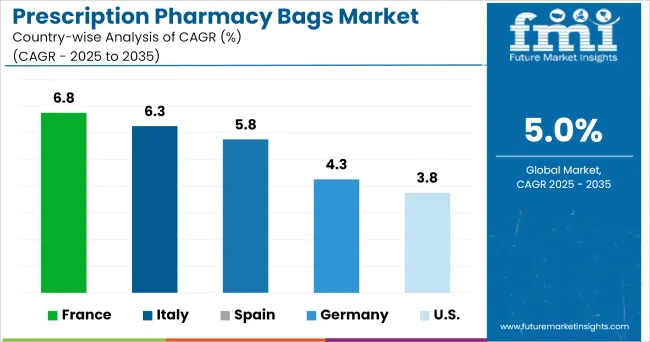
Ongoing research and development in recycled paper-based packaging are expected to drive prescription pharmacy bags market growth since they provide a low-cost raw material that can be used to reduce plastic pollution.
Customers criticised Boots, the UK's top pharmaceutical and beauty products retailer, for utilising plastic prescription bags. With increased consumer understanding about what plastic may do to the environment, Europe prescription pharmacy bags are anticipated to foresee substantial growth in the paper bag segment.
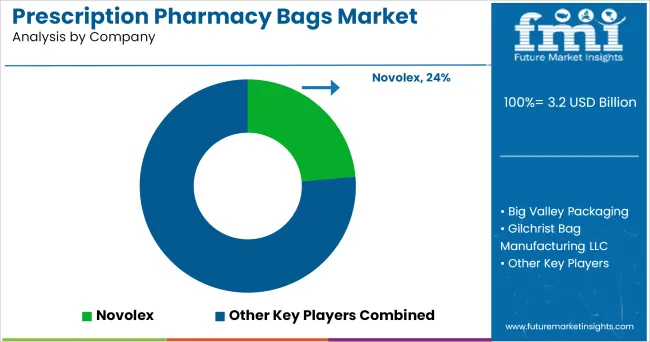
Some key players in the prescription pharmacy bags market includes
The global prescription pharmacy bags market is estimated to be valued at USD 3.2 billion in 2025.
The market size for the prescription pharmacy bags market is projected to reach USD 5.2 billion by 2035.
The prescription pharmacy bags market is expected to grow at a 5.0% CAGR between 2025 and 2035.
The key product types in prescription pharmacy bags market are flat bag, square-bottomed bag and gusseted bag.
In terms of based on material, paper segment to command 61.3% share in the prescription pharmacy bags market in 2025.






Our Research Products

The "Full Research Suite" delivers actionable market intel, deep dives on markets or technologies, so clients act faster, cut risk, and unlock growth.

The Leaderboard benchmarks and ranks top vendors, classifying them as Established Leaders, Leading Challengers, or Disruptors & Challengers.

Locates where complements amplify value and substitutes erode it, forecasting net impact by horizon

We deliver granular, decision-grade intel: market sizing, 5-year forecasts, pricing, adoption, usage, revenue, and operational KPIs—plus competitor tracking, regulation, and value chains—across 60 countries broadly.

Spot the shifts before they hit your P&L. We track inflection points, adoption curves, pricing moves, and ecosystem plays to show where demand is heading, why it is changing, and what to do next across high-growth markets and disruptive tech

Real-time reads of user behavior. We track shifting priorities, perceptions of today’s and next-gen services, and provider experience, then pace how fast tech moves from trial to adoption, blending buyer, consumer, and channel inputs with social signals (#WhySwitch, #UX).

Partner with our analyst team to build a custom report designed around your business priorities. From analysing market trends to assessing competitors or crafting bespoke datasets, we tailor insights to your needs.
Supplier Intelligence
Discovery & Profiling
Capacity & Footprint
Performance & Risk
Compliance & Governance
Commercial Readiness
Who Supplies Whom
Scorecards & Shortlists
Playbooks & Docs
Category Intelligence
Definition & Scope
Demand & Use Cases
Cost Drivers
Market Structure
Supply Chain Map
Trade & Policy
Operating Norms
Deliverables
Buyer Intelligence
Account Basics
Spend & Scope
Procurement Model
Vendor Requirements
Terms & Policies
Entry Strategy
Pain Points & Triggers
Outputs
Pricing Analysis
Benchmarks
Trends
Should-Cost
Indexation
Landed Cost
Commercial Terms
Deliverables
Brand Analysis
Positioning & Value Prop
Share & Presence
Customer Evidence
Go-to-Market
Digital & Reputation
Compliance & Trust
KPIs & Gaps
Outputs
Full Research Suite comprises of:
Market outlook & trends analysis
Interviews & case studies
Strategic recommendations
Vendor profiles & capabilities analysis
5-year forecasts
8 regions and 60+ country-level data splits
Market segment data splits
12 months of continuous data updates
DELIVERED AS:
PDF EXCEL ONLINE
Industry Share & Competitive Positioning in Prescription Pharmacy Bags Market
Prescription Delivery Service Market Size and Share Forecast Outlook 2025 to 2035
Prescription Bottles Market Size and Share Forecast Outlook 2025 to 2035
Competitive Landscape of Prescription Bottles Suppliers
Key Companies & Market Share in the Prescription Lens Industry
Omega 3 Prescription Drugs Market Size and Share Forecast Outlook 2025 to 2035
Recycled Prescription Bag Market Size and Share Forecast Outlook 2025 to 2035
Market Share Breakdown of Recycled Prescription Bag Industry
Pharmacy Refrigerators Market Size and Share Forecast Outlook 2025 to 2035
Pharmacy Automation Market Trend Analysis Based on Product, End-Use, and Regions 2025 to 2035
Pharmacy and Drug Store Franchises Market is segmented by Type and Age Group from 2025 to 2035
Pharmacy Automation System Market Growth – Demand & Forecast 2024-2034
Pharmacy Accessory Bagging System (PABS) Market
Pharmacy Bags Market Size and Share Forecast Outlook 2025 to 2035
Market Share Distribution Among Pharmacy Bags Manufacturers
ePharmacy Market Overview – Trends, Demand & Forecast 2025 to 2035
Infusion Pharmacy Management Market
Polybags Market Size and Share Forecast Outlook 2025 to 2035
Net Bags Market
VCI Bags Market

Thank you!
You will receive an email from our Business Development Manager. Please be sure to check your SPAM/JUNK folder too.
Chat With
MaRIA